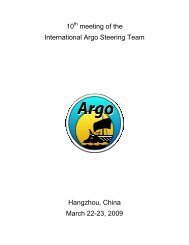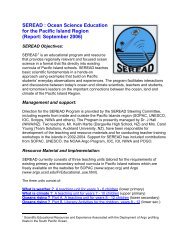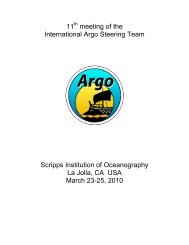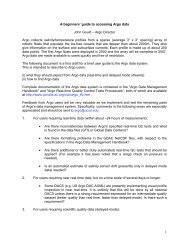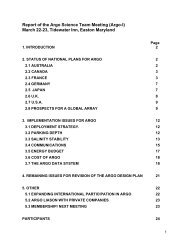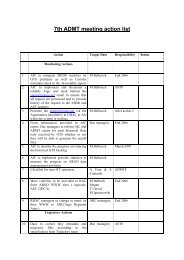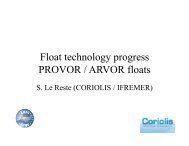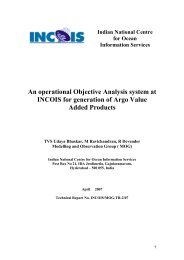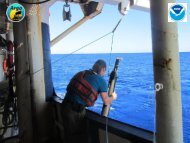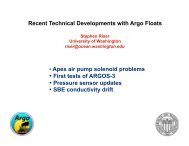AST-12 meeting report posted - Argo
AST-12 meeting report posted - Argo
AST-12 meeting report posted - Argo
You also want an ePaper? Increase the reach of your titles
YUMPU automatically turns print PDFs into web optimized ePapers that Google loves.
5.4 Transition to new ARGOS location method<br />
The TC presented, on behalf of CLS, the new method for <strong>Argo</strong>s locations calculation based on<br />
Kalman filtering. Basically the method uses historical locations to improve the positioning.<br />
This method provides more positions (+~10%) and better accuracy (+ 100% class 3) than the<br />
least squares processing and automatically corrects unrealistic positions. It is to be noted that<br />
when this new method fails, the processing is reinitialized with the classic least square system<br />
(as for a first location calculation).<br />
Documentation, including a set of tests on 20 floats comparing both methods, is available at:<br />
ftp://ftp.jcommops.org/<strong>Argo</strong>/ARGOS.<br />
The TC invited the <strong>AST</strong> to decide a date for the community to switch to this new method so that<br />
datasets are improved homogeneously. The panel agreed on early June for the switch date and<br />
invited trajectory experts to explore further the new method before the deadline.<br />
Action item 20: Ask DACs and interested PIs to evaluate the new <strong>Argo</strong>s positioning<br />
system to decide if <strong>Argo</strong> wants to adopt it. Report results back to M. Scanderbeg by 20 May<br />
2011. Unless a problem is found, all of <strong>Argo</strong> will switch to the new system in June 2011. DACs<br />
and interested PI’s, M. Scanderbeg.<br />
Action item 21: If <strong>Argo</strong> decides to adopt the new <strong>Argo</strong>s positioning system, explore the<br />
offer of CLS to reprocess all <strong>Argo</strong>s data from 2008 onwards. ATC, <strong>AST</strong> co-chairs.<br />
5.5 CCHDO and NODC activity<br />
Action item 22: Coriolis to make a new historical reference database for DMQC<br />
purposes on a twice yearly basis. Explore why this has not occurred in the past. S. Pouliquen<br />
Action item 23: Ask J. Gilson to repeat his comparison of <strong>Argo</strong> profile reference<br />
database to updated historical reference database to see if it is improving in the Southern<br />
Ocean. J. Gilson.<br />
Action item 24: Provide CCHDO known upcoming CTD cruise track and dates to enter<br />
into the CruiseTracker database. PIs, CCHDO<br />
Action item 25: AIC to invite float operators to also give information when notifying<br />
deployment plans on whether CTD and oxygen will be done on deployment cruises. ATC.<br />
6 Technical issues<br />
6.1 Float technology progress<br />
Float technology progress on PROVOR / ARVOR floats presented by V. Thierry and<br />
prepared by S. Le Reste<br />
Oxygen sensor: Thirteen PROVOR floats equipped with Aanderaa optode oxygen sensors<br />
have been deployed in the North-Atlantic in June 2010 and are working well. The float<br />
technology is now mature. Work is on-going to improve measurements accuracy. A <strong>meeting</strong> on<br />
this issue will be held in May in Brest, France.<br />
21



